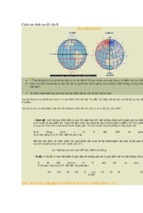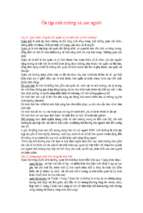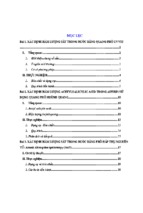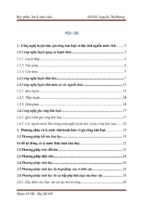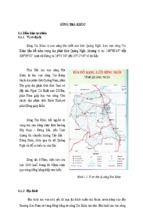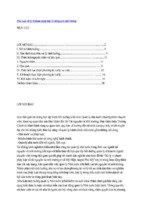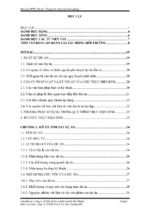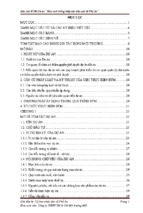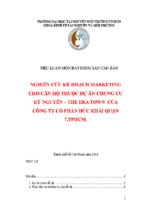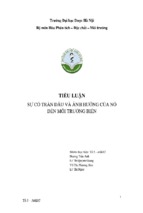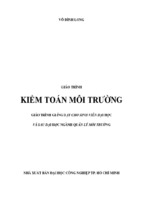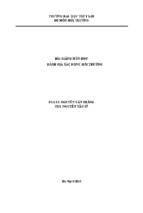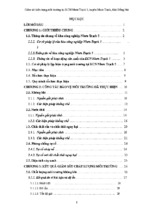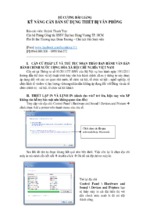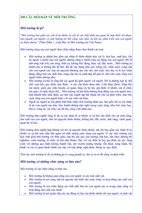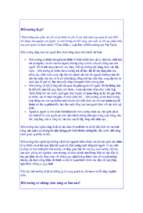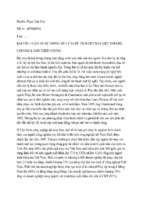Xác định các hợp chất hữu cơ dễ bay hơi họ clo bằng GC
Application Note - AN 107
Determination of Volatile Organic
Compounds (VOCs) in Water
Part 1: Chlorinated VOCs
INTRODUCTION
INSTRUMENTATION
Volatile Organic Compounds (VOCs) are carbon-containing
In the MASTER DHS, operated in purging mode, the sample is
molecules that readily evaporate at normal air temperature.
placed in a sealed vial and thermostatted in a temperature-
Fuel oils, gasoline, industrial solvents, paints, and dyes are the
controlled oven. The use of a precise flow of inert gas through
major sources of VOCs and their improper discharge may cause
an original dual-needle enables the volatiles to be swept from
severe damages to the environment and the human health.
the liquid sample and focused in a sorbent packed trap (see
Therefore the determination of low concentrations of VOCs is
Figure 1). The analytes are then rapidly thermally desorbed,
of utmost importance when assessing the quality of drinking
passed through the “Dew Stop”, to remove most of the water,
and raw source water. The U.S. Environmental Protection
and introduced directly into the GC system (see Figure 2).
Agency (EPA) estimates that VOCs are present in one-fifth of
the nation’s water supplies. For this reason, government
agencies
require
monitoring
of
these
contaminants
SAMPLE VIAL
at
progressively lower levels. Several EPA methods require the
TRAP
use of purge and trap (P&T) systems to extract VOCs from
water, although the technique is generally considered to be
very burdensome [1].
This study presents the analysis of 37 EPA Method 502.2
targeted chlorinated VOCs by means of Dynamic HeadspaceGas Chromatography (DHS-GC) [2]. The headspace sampling
system consists of the MASTER DHS Dynamic Head Space
Figure 1. Superior sensitivity is obtained through the constant
sweeping of the thermostatted sample, promoting the
enrichment of the volatile compounds on the sorbent trap.
Sampler, equipped with the MASTER AS Automatic Sampler,
operated in “purging mode”, according to the aforementioned
EPA method. The extracted VOCs are then analyzed by GC
TRAP
DEW STOP
GC
combined with the highly sensitive and selective Electron
Capture Detector (ECD). The obtained results demonstrate that
the Dynamic Headspace sampling technique provides a
sensitivity exceeding the low-level threshold required by the
latest
regulations.
Data
are
reported
including
linear
calibrations and method detection limits.
Figure 2. Analytes are rapidly thermally desorbed and passed
through the ingenious Dew Stop device which efficiently
removes water regardless of the analytes .
1
In combination with the MASTER AS Automatic Sampler, the
MASTER DHS allows sample overlapping with constant
incubation time increasing sample capacity and optimizing the
vial processing for maximum system productivity.
EXPERIMENTAL
Sample
A volume of 10 mL of a standard solution containing 1 ppb of
each compound in water was added to a 20-mL vial. The
standard solution was purchased from Supelco (Product No.
47933).
System configuration and control
DHS and GC-ECD conditions are summarized in Table 1.
ECD: The detector is selective to electronegative compounds,
e.g. organic compounds containing chlorine and fluorine atoms
in their molecules.
It is the first option for environmental measurements, offering
excellent performance in the determination of halogenated
organic compounds due to the sensitivity 10 to 1,000 higher
than the Flame Ionization Detector (FID).
TABLE 1. DHS-GC-ECD EXPERIMENTAL CONDITIONS
MASTER DHS
Sample Volume
Trap Material
Operating Mode
Valve Temp.
Transfer Line Temp.
Incubation Temp.
Stripping Time
Stripping Flow
Trap Stripping Temp.
Injection Time
Trap Injection Temp.
Dew Stop Temp.
Baking Time
Trap Baking Temp.
Dew Stop Baking Temp.
Baking Flow
10 mL
Tenax/ Carbotrap/ Carbosieve
Purging Mode
250 °C
250 °C
60 °C
3 min
120 mL/min
-10 °C
3 min
295 °C
0 °C
10 min
300 °C
200 °C
80 mL/min
MASTER GC
Column
Oven
Injector
Carrier Gas Flow (He)
Detector
Vocol (Supelco)
60 m x 0.32 mm, 3 μm
35 °C (8 min) at 4 °C/min to
240 °C (1 min)
SL/IN (220 °C)
3.5 mL/min (split 1:2)
ECD (300 °C, 40 mL/min N2)
Calibration
Chromatography Station software provides full
A method calibration covering the entire analytical range for
control of the MASTER DHS and the MASTER GC, data
each target analyte was performed. A six-concentration-level
acquisition and processing.
calibration curve was plotted and the applied calibration ranges
The Clarity
TM
are described in Table 2.
Figure 3. The MASTER DHS unit
combined with the MASTER AS is easily
hyphenated to the MASTER GC.
2
RESULTS
High sensitivity is obtained through the constant sweeping of
the thermostatted sample, promoting the enrichment of the
The chromatogram in Figure 4 shows the separation obtained
volatile compounds on the sorbent trap. Moreover, the proper
for the 1 ppb VOCs mixture. In addition, calibration curves
selection of the sorbent materials and trap temperature
were prepared using a six points curve model, correlation
settings also contribute to the efficient collection
factors (R) are reported in Table 2.
and
concentration of the target analytes.
Method detectable limits (MDLs) for all the listed target
The electrical cooling device of the trap and the programmable
analytes obtained using the same conditions and calculations
Dew Stop, which efficiently removes water maintaining volatile
are listed in Table 2. The obtained values were very low and
compounds recovery unaffected, further enhance sensitivity.
well below currently recommended limits, e.g. EPA Method
502.2. Moreover, excellent precision was attained. MDLs and
relative standard deviations (RSD%) cited in the EPA Method
502.2 are also listed for comparison.
15
24 + 25
16
22
10 + 11
20 + 21
7 8 9
23
13
26
27
17
18
37
19
6
2
1
4
12
30 + 31
14
32
5
3
33
28
29
36
34
35
FIGURE 4. DHS-GC-ECD chromatogram of the chlorinated VOCs mixture (1 ppb). The numbers refer to those in Table 2.
3
CONCLUSION
TABLE 2. COMPOSITION OF THE CHLORINATED VOCS MIXTURE.
EPA 502.2
Compounds
The high sensitivity of the system confirmed the
Range (ppb)
R
MDL (ppb)
RSD%
MDL (ppb)
RSD%
0.1 - 2
0.957
0.01
1.5
0.07
2.8
operated in “purging mode”. The proposed
method
applicability of the Dynamic Headspace sampler
1
1,1 Dichloroethylene
2
Methylene choride
0.01 - 10
0.996
0.002
2.0
0.02
2.9
3
trans-1,2-Dichloroethylene
0.01 - 10
0.997
0.03
3.0
0.06
3.7
4
1,1-Dichloroethane
0.02 - 2
0.997
0.003
2.2
0.07
5.7
5
2,2-Dichloropropane
0.0002 - 10
0.999
0.005
1.1
0.05
3.4
6
cis-1,2-Dichloroethylene
0.02 - 10
0.999
0.01
16.6
0.01
3.3
7
Chloroform
0.04 - 2
0.985
0.0005
0.8
0.02
2.5
8
Bromochloromethane
0.04 - 1
0.994
0.0005
0.8
0.01
3.0
Unlike conventional Purge and Trap systems,
9
1,1,1-Trichloroethane
0.002 - 2
0.998
0.0005
0.9
0.03
3.3
the MASTER DHS uses disposable vials thus
10
1,1-Dichloropropylene
0.01 - 1
0.994
0.0003
0.7
0.02
3.3
eliminating any risk of carry-over effects.
11
Carbon tetrachloride
0.02 - 1
0.997
0.0003
0.7
0.01
3.6
12
1,2-Dichloroethane
0.01 - 1
0.998
0.002
0.5
0.03
3.8
In combination with the MASTER AS Automatic
13
Trichloroethylene
0.01 - 1
0.998
0.0005
1.2
0.01
3.6
Sampler, the MASTER DHS allows sample
14
1,2-Dichloropropane
0.002 - 1
0.996
0.002
1.3
0.01
3.7
overlapping
15
Bromodichloromethane
0.04 - 0.1
0.995
0.0003
0.8
0.02
2.9
increasing laboratory productivity and sample
16
Dibromomethane
0.01 - 1
0.964
0.0003
1.6
0.02
1.5
17
cis-1,3-Dichloropropylene
0.0002 - 2
0.994
0.0007
2.0
0.06
3.7
throughput: the system automatically controls
18
trans-1,3-Dichloropropylene
0.0002 - 2
0.997
0.001
1.6
0.01
33.7
19
1,1,2-Trichloroethane
0.0002 - 2
0.995
0.0014
1.5
N.D.
5.6
20
1,3-Dichloropropane
0.04 - 2
0.998
0.0004
0.7
0.03
3.1
21
Tetrachloroethylene
0.04 - 2
0.998
0.0004
0.7
0.04
2.5
22
Dibromochloromethane
0.04 - 1
0.960
0.0003
0.5
0.8
2.8
23
1,2-Dibromoethane
0.002 - 1
0.994
0.0005
0.9
2.2
6.7
24
Chlorobenzene
0.01 - 1
0.995
0.0003
0.9
0.01
3.6
25
1,1,1,2-Tetrachloroethane
0.01 - 1
0.995
0.0003
0.9
0.01
2.3
26
Bromoform
0.01 - 1
0.998
0.0005
1.0
1.6
5.2
27
1,1,2,2-Tetrachloroethane
0.0002 - 1
0.999
0.0007
1.6
0.01
6.8
28
1,2,3-Trichloropropane
0.01 - 1
0.997
0.0025
0.8
0.4
2.3
29
Bromobenzene
0.2 - 2
0.995
0.012
1.6
0.03
2.7
30
2-Chlorotoluene
0.02 - 2
0.998
0.002
3.3
0.01
2.7
[1] R.L. Grob and E.F. Barry. Modern Practice
31
4-Chlorotoluene
0.02 - 2
0.998
0.002
3.3
0.01
3.2
of Gas Chromatography. Wiley, New York,
32
1,3-Dichlorobenzene
0.2 - 10
0.999
0.007
0.2
0.02
4.0
33
1,4-Dichlorobenzene
0.4 - 10
0.999
0.018
3.4
0.01
2.3
34
1,2-Dichlorobenzene
0.2 - 10
0.999
0.01
3.0
0.02
1.5
35
1,2-Dibromo-3-chloropropane
0.2 - 2
0.998
0.005
4.0
3.0
11.3
36
1,2,4-Trichlorobenzene
0.1 - 10
0.999
0.004
2.8
0.03
2.1
37
1,2,3-Trichlorobenzene
0.1 - 10
0.999
0.0012
2.5
0.03
3.1
for
the
precise
and
reliable
determination of chlorinated VOCs exceeds the
low-level threshold required by the latest
regulations.
with
constant
incubation
time
that the next sample is thermostatted during
the GC analysis of the previous one.
REFERENCES
4th ed., 2004.
[2] Volatile organic compounds in water by
purge and trap capillary column gas
chromatography with photoionization and
electrolytic conductivity detectors in series.
U.S.
Office
Environmental
of
Research
Protection
and
Agency,
Development,
Washington, D.C., Method 502.2, revision
2.1, August 1995.
4
- Xem thêm -


